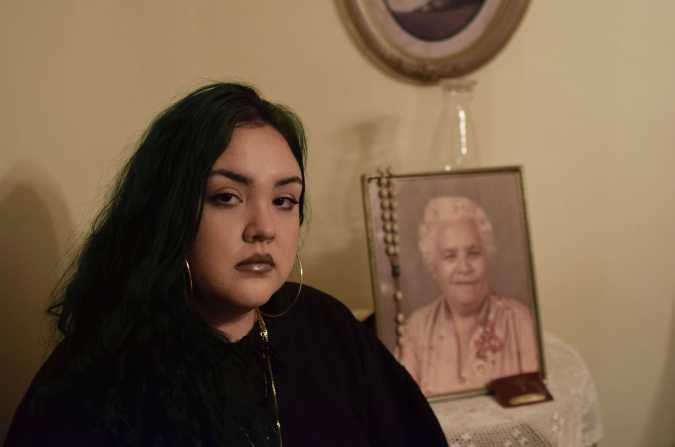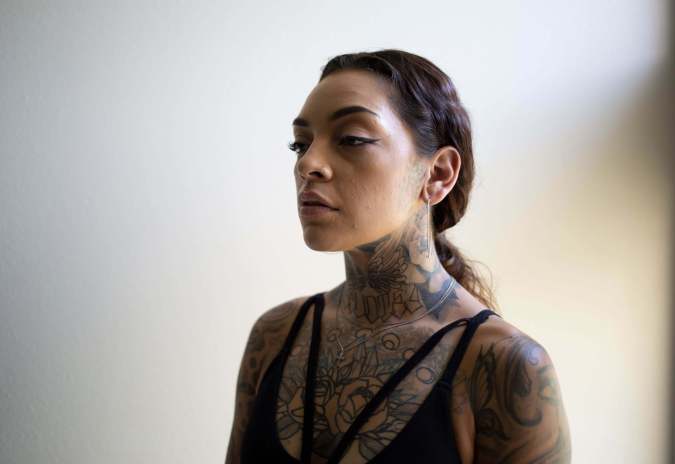Drug addiction and street violence often show up as statistics in news stories or warning signs about a part of town gone wrong, but photographer Frank Blazquez wants to change that. He doesn’t aim to do this by skirting around the situation but rather by sharing the stories of people who lived through it. He’s one of them.
“I really started to use still photography as a means of a healing process.”
In 2016, Blazquez started “Barrios de Nuevo Mexico: Southwest Stories of Vindication,” a photo and documentary film series that chronicles the people and stories of Albuquerque, New Mexico’s “war zone” — the name residents gave to this high-crime area — from a very personal vantage point. A portion of the series has been shown at Spanish Colonial Museum, Santa Fe, the Historic Santa Fe Foundation, Santa Fe and the Sangre de Cristo Arts Center.
Last year, Blazquez shared his story in The Guardian, writing that after dealing with a drug addiction he hoped to find reprieve in the “sun-drenched paradise” of New Mexico. Instead, he became hooked on OxyContin. That was in 2010. Six years later, he decided to get clean.
At the time, he started an Instagram account with his photography and soon realized that the camera could serve as a humanizing tool for misunderstood people like himself.
“That’s when I really started to use still photography as a means of a healing process,” Blazquez tells Remezcla. “And what better way to do that, in my opinion, than to actually mediate your own personal narrative and your own story.”

The project turned into a way to “help other people that might be in the same position.” Blazquez started with the people in Albuquerque he already knew, a challenging yet cathartic choice. Blazquez describes it as a decision to “go back into the fire” in order to come to terms with his past.
“I felt like I was on the outside looking in and seeing myself and seeing the choices that I used to make,” Blazquez says. “But now with a camera … you’re able to capture light in certain environments, you’re able to get situations and scenarios and events, and you’re able to isolate them so you can start to dissect them and study them, and start to explore why you did those things that you did.”
“I was on the outside looking in and seeing myself and seeing the choices that I used to make.”
According to the University of New Mexico Health Sciences Center, New Mexico has “one of the highest rates of opioid deaths in the U.S.” In 2014, approximately 500 people died in cases related to opioids. In February, New Mexico expanded an existing lawsuit regarding the opioid crisis by including companies like CVS, Walgreens and Walmart, according to the Associated Press. The lawsuit primarily “accuses opioid manufacturers of aggressively pushing highly addictive and dangerous drugs.”
Because of the many stories Blazquez started to document, he felt the need to move from solely a photo series (the one he started in 2016) to videos and installations. His close-up portraits often depict the subject with a simple background. They feel immediate and sometimes caught in the moment, as if Blazquez took the photos during a lull in conversation.
People who view his work sometimes ask, “why do you focus so much on people that are negative” or “why do you focus on the bad?” For Blazquez, these questions are confusing because he feels he’s simply taking portraits. The subjects’ stories, which his photography emphasizes, are what’s important, largely because of the struggles they might’ve been through or the challenges they continue to fight against.
Blazquez grew up loving documentary films, particularly anything about true crime or street culture. With the videos series Duke City Diaries, which he does in collaboration with filmmaker John Acosta, the people he portrays are able to tell their story with more detail. In one episode, for example, Carlos Sanchez shares how he went from selling drugs to now working as an executive assistant at Heading Home, a nonprofit that “provides emergency housing, permanent supportive housing services and prioritized street outreach to people experiencing homelessness,” according to its website. He is also the co-director for the city’s winter shelter.

Blazquez is looking forward to seeing how the project continues to transform, both from an artistic standpoint and a personal one.
“I started a new project called ‘Mexican Suburbs,’ which is an offshoot of that same feeling that I have in my portraiture,” Blazquez says. “I’m starting to take more of an authority position in trying to define who I am as a Mexican-American artist.”
“Let’s just simply look into someone else’s life.”
Part of that means taking a lens to the areas he once frequented in the hardest times of his life.
“Why travel to somewhere far away or to a different state when I should probably focus on just the corners that are right outside of my house,” Blazquez says.
He realizes that, in many ways, making art is “still a privilege.” It requires time, resources and energy that many of the people he encounters can’t currently afford as they fight for their own survival.
In telling these stories through photography and videography, he hopes he can create a positive effect on his subjects while expanding viewers’ knowledge of New Mexico, life and drug addiction.
“Let’s just open up a window and let’s just simply look into someone else’s life,” Blazquez says.
Barrios de Nuevo Mexico will show at Crystal Bridges Museum in February for State of the Art 2020.




